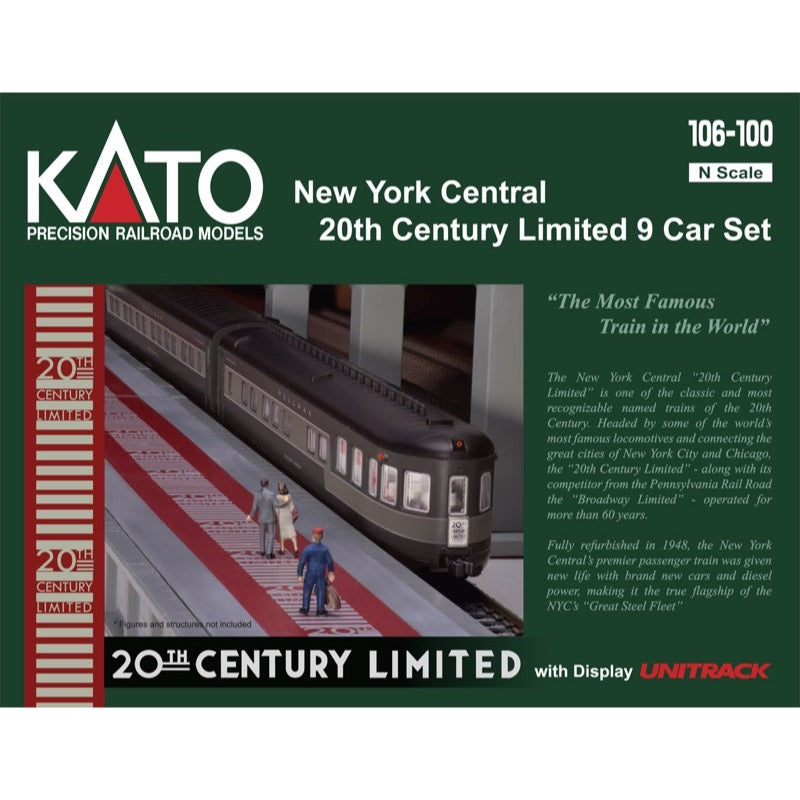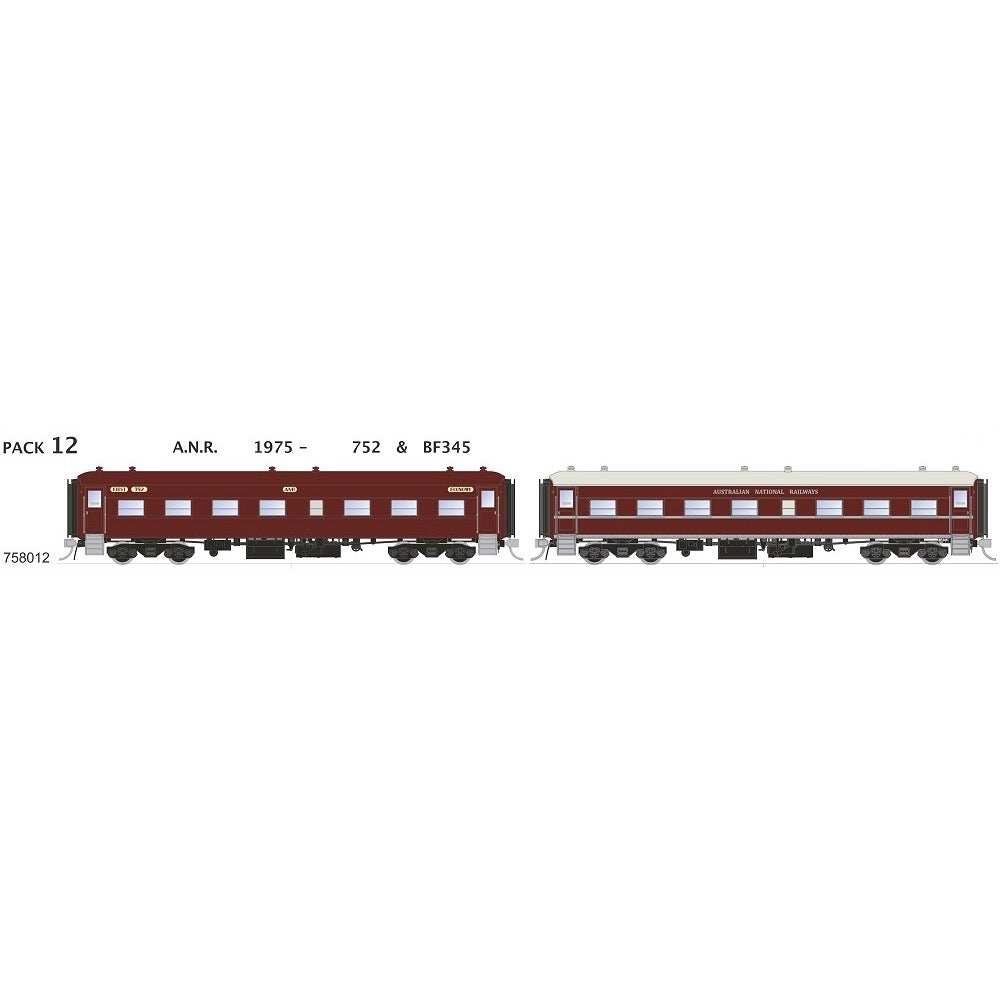
SDS Models 758012 HO SAR 700 Class Passenger Cars Pack 12 ANR 752 and BF345 2 Car Pack
125.00
$
<p>The South Australian Railways introduced 36 steel bodied country passenger cars between 1936 and 1941. Of these cars the last 24 built, entered service in 1940/41. They were all of a similar external appearance and the same overall length.</p>
<p>16 were coded 700 to 715, these were Second class centre aisle cars. 4 were coded 750 to 753, these were Composite class centre aisle cars. 4 were coded 780 to 783, these First class centre aisle cars.</p>
<p>Originally introduced with frameless full drop windows, they were progressively replaced with half drop chrome plated framed windows from the mid 1950s through to the very early 1960s.</p>
<p>Introduced in Hawthorn green and cream with black roofs up until the mid to late 1960s, when they were progressively repainted into Regal red and Silver to match the newer country stock.</p>
<p>In the early 1970s 4 cars were transferred to standard gauge to work between Broken Hill and Peterborough. Later in the early 1980s several cars were hired to Victorian Railways.</p>
<p>Many 700 series cars also saw service with West Coast Railway in Victoria, Steam Ranger in South Australia, North Rivers Railroad with Ritz Rail in Northern NSW.</p>
<h3>Features</h3>
<ul>
<li>Highly detailed Ready-to-Run 1/87 Scale HO gauge model </li>
<li>18” Minimum radius recommended</li>
<li>Precisely tooled plastic body (ABS)</li>
<li>Genuine Kadee scale head whisker coupler </li>
<li>Separately applied handrails and detail parts</li>
<li>Two body style options: Original 8 vent roof and later 13 vent roof</li>
<li>Two window style options: Original Beclawat frameless full drop window and later Wahner framed half drop window</li>
<li>Three full interior options for each class and with appropriate seat covering colour</li>
</ul>

Hornby TT4028 TT BR Intercity Mk3 Tourist Guard Standard 44063
27.00
$
<p>In-order to allow running at 125 mph on Britain's Victorian era railways, new rolling stock was needed by British Railways. Significant improvements over the Mk2 included new secondary air suspension between the bogies and the coach body as well as aerodynamic skirting on the underframe.</p>
<p>Mk3 coaches are 75ft (23m) long, enabling far greater capacity than older coaches. Mk3 coaches also incorporate disk brakes and wheel slip protection enabling faster deceleration. The first Mk3 coaches to be delivered were used as part of the HST prototype along with the two Class 41 diesel power cars in 1972. Mk3 coaches entered service in 1975 along with the Class 43 forming the iconic InterCity 125 trainset. After the HST Mk3 coach variant was introduced, further Mk3 coaches were introduced to the West Coast Mainline for use as part of locomotive hauled trains. Whilst Mk3 stock is standard for HST units, the standard locomotive hauled stock is Mk3a. Mk3a stock differs from Mk3 stock due to the inclusion of buffers as well as a different electrical system that uses motor generator units in each coach to power air conditioning and other ancillaries Mk3a stock was built until 1984, before 3B stock with improved seating and lighting was built from 1985 to 1988.</p>
<p>As BR began to move away from the corporate blue livery, some of the Mark 3 coaches and complimentary Class 43 units were painted into a new Intercity Executive livery. This livery consisted of a dark grey upper body, a stripe of white and red and a light beige sand colour on the bottom of the body. While this would be a popular and long lasting livery, the name Executive was dropped from the side of the units as the livery took over as the only one applied to Intercity sets.</p>
<h3>Specification</h3>
<ul>
<li>Item Length - Without Packaging (cm): 19</li>
<li>Item Height - Without Packaging (cm): 2.2</li>
<li>Item Width - Without Packaging (cm): 2</li>
<li>Item Weight - Without Packaging: 0.05</li>
<li>Item Scale: 1:120 Scale</li>
<li>Finish: Painted</li>
<li>Colour: Multiple</li>
<li>Gauge: TT</li>
<li>Operator: BR</li>
<li>Designer: BR</li>
<li>Livery: BR Intercity</li>
<li>Minimum Curve (mm): Radius 1</li>
<li>Number of Parts: 1</li>
</ul>
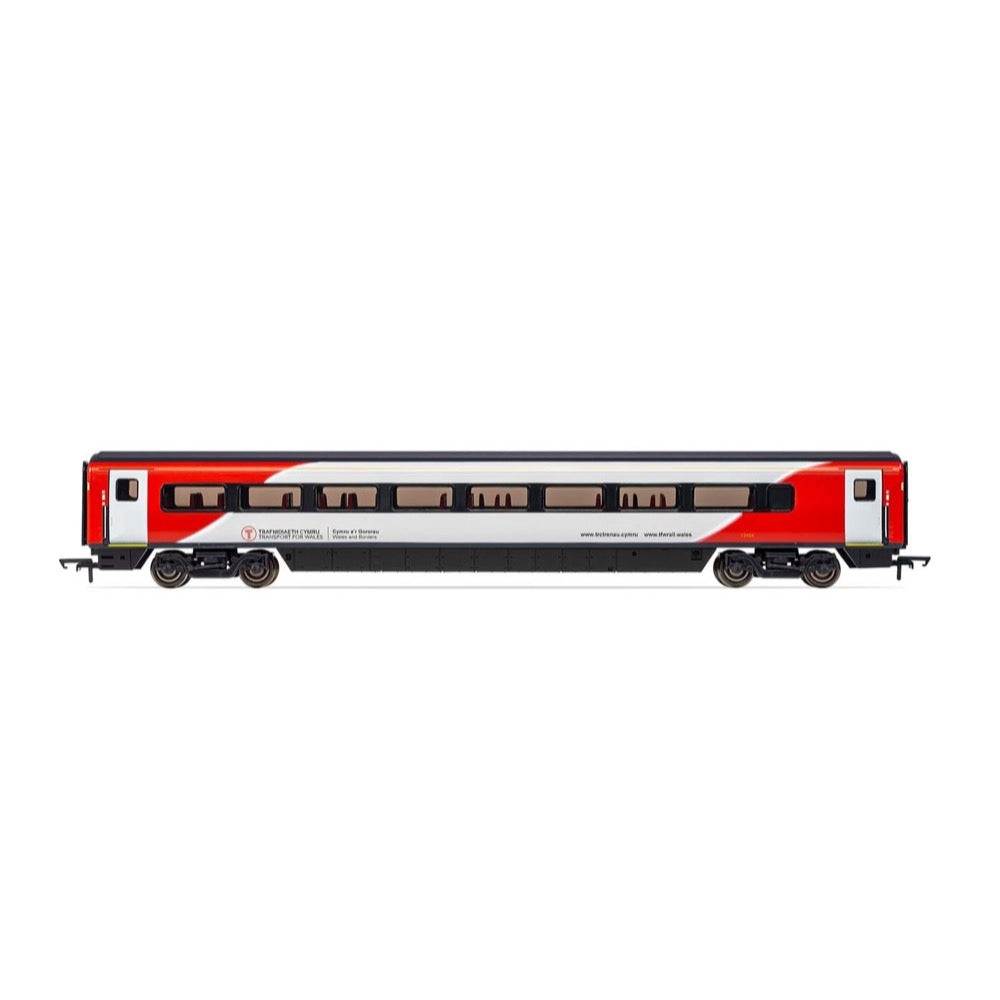
Hornby R40187A OO Transport for Wales Mk4 Standard Coach C
40.00
$
<p>Built at Metro-Cammell's Washwood Heath factory, 314 Mk4 coaches were produced between 1989 and 1992. They were built specifically for use on the newly electrified East Coast Main Line, along with hopes that a second order for the West Coast Main Line would be placed at a later date, although this second order never transpired. Mk4 coaches featured many improvements over the Mk3s such as push-button operated plug-type doors, fully sealed gangways and a designed top speed of 140mph. Much of the Mk4 design was based upon the Advanced Passenger Train. In particular, Mk4 coaches feature sides profiled to allow a tilt of up to 6° with newly fitted tilting bogies.</p>
<p>Mk4s entered service in 1989 and helped drive a significant increase in passenger traffic. With privatisation in 1996, all Mk4 coaches were sold to Evershot Rail Group who have since leased them out to the holder of the InterCity East Coast Franchise. The franchise was initially awarded to Great North Eastern Railway (GNER) and has since been operated by National Express East Coast, East Coast, Virgin Trains East Coast and London North Eastern Railway (LNER) owned by the Department for Transport.</p>
<p>Between October 2003 and November 2005 Bombardier Transportation, under contract from GNER, commenced refurbishment of the Mk4 stock, fitting new seating arrangements and introduced onboard Wi-Fi, a first for British rail services. This refurbishment programme was called 'Project Mallard' named after the Mallard steam locomotive, built in the 1930s by the London & North Eastern Railway and holder of the world speed record for steam locomotives.</p>
<p>Although Mk4 coaches have spent most of their lives on the ECML, there are plans to cascade them down to other lines due to the introduction of the Class 800 and Class 801 IEPs.</p>
<h3>Specifications</h3>
<ul>
<li>Item Length - Without Packaging (cm): 33</li>
<li>Item Height - Without Packaging (cm): 5</li>
<li>Item Width - Without Packaging (cm): 3.5</li>
<li>Item Weight - Without Packaging: 0.2</li>
<li>Item Scale: 1:76 Scale 00 Gauge</li>
<li>License: No</li>
<li>Finish: Painted</li>
<li>Colour: Grey</li>
<li>Gauge: OO</li>
<li>Operator: Transport for Wales</li>
<li>Designer: Met Cam</li>
<li>Livery: Transport for Wales</li>
<li>Minimum Curve (mm): Radius 2</li>
<li>Number of Parts: 1</li>
</ul>

Hornby R4939 Cross Country Trains Mk3 Sliding Door TSD - Era 11
27.00
$
<p>The British Rail Mark 3 is a type of passenger carriage developed in response to growing competition from airlines and the car in the 1960s. A variant of the Mark 3 became the rolling stock for the High Speed Train (HST).</p>
<p>Originally conceived as locomotive-hauled coaching stock, the first coaches built were for the prototype HST in 1972. Production coaches entered service between 1975 and 1988, and multiple-unit designs based on the Mark 3 bodyshell continued to be built until the early 1990s. Most of the surviving fleet of the Mark 3 and its derivatives are still in revenue service on the British railway network in 2019.</p>
<h3>Specifications</h3>
<ul>
<li>Operator/Livery: Cross Country, Purple/Grey</li>
<li>Livery Finish: Pristine</li>
<li>Length: 303mm</li>
<li>Period/ERA: Era 11 (2014 +)</li>
<li>Type/Class: BR Mk.3 TSD Trailer Standard Disabled</li>
<li>Designer: Wabtec Doncaster</li>
</ul>

Hornby R60043 OO MCS and Fesco Container Pack 1 x 20ft and 1 x 40ft Containers
19.00
$
<p>Container Pack featuring 1 x 20' MCS container and 1 x 40' Fesco container.</p>
<h3>Specifications</h3>
<ul>
<li>Item Length - Without Packaging (cm): 16</li>
<li>Item Height - Without Packaging (cm): 5</li>
<li>Item Width - Without Packaging (cm): 3.5</li>
<li>Item Weight - Without Packaging: 0.06</li>
<li>Item Scale: 1:76 Scale 00 Gauge</li>
<li>License: No</li>
<li>Finish: Painted</li>
<li>Colour: Mixed</li>
<li>Gauge: OO</li>
<li>Operator: Private owner</li>
<li>Livery: Private owner</li>
<li>Number of Parts: 2</li>
</ul>
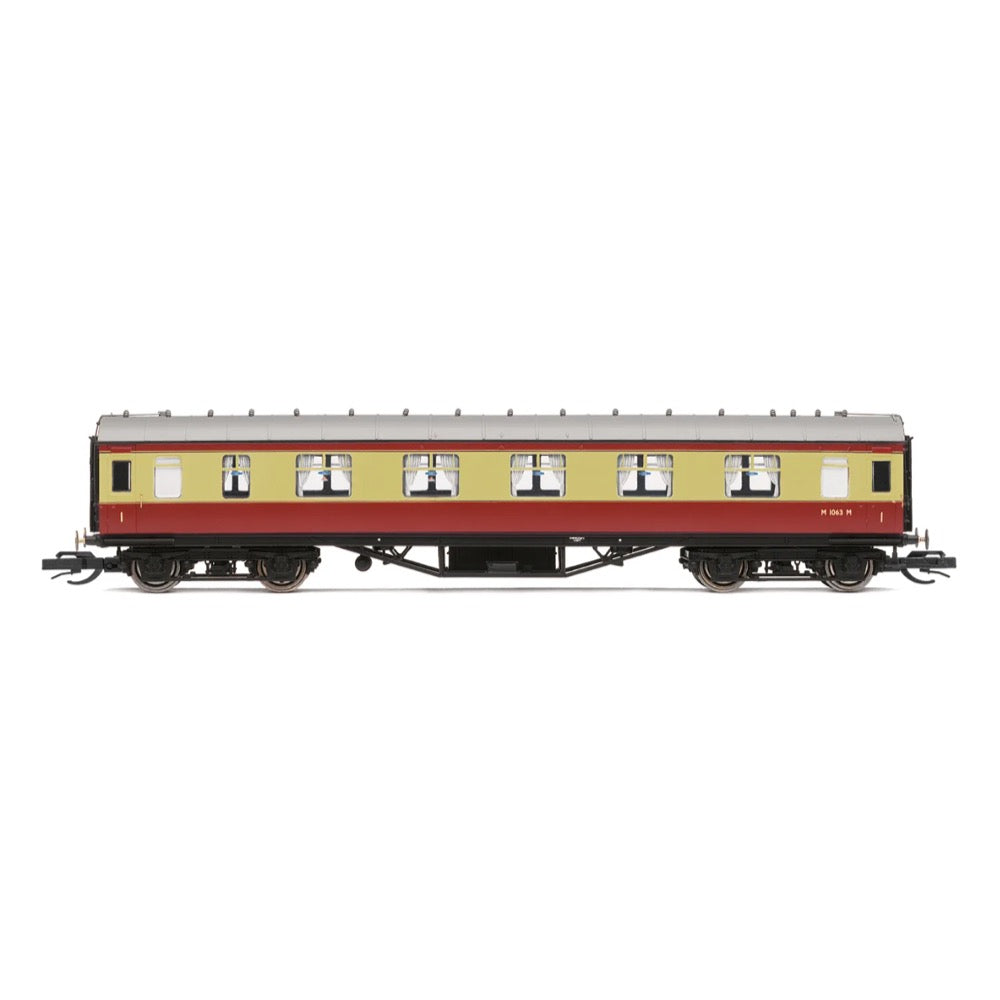
Hornby TT4036 TT BR 57 Corridor First M1063M
27.00
$
<p>At the start of the 1930s the LMS abandoned the ‘Small Engine Policy that it had inherited from one of its largest predecessors, the Midland Railway. The abandoning of this policy led to some of the most famous Stanier and LMS designs such as the Jubilee, Black 5 and Duchess classes. To accompany this shift in ethos, new coaches were constructed for the LMS, with the 57’ coaches being built between 1931 and 1932.</p><p>These new coaches were steel clad, the first such for the LMS and had seating for 56, 300 such examples were built. In LMS service these coaches were painted in their striking maroon livery with LMS insignia adorning the side. The coaches, being relatively new at the time of nationalisation lasted well into the swansong days of BR, appearing in both its carmine and cream livery and later BR Maroon when BR decided to shift aesthetics back to regional recognition.</p><h3>Specifications</h3><ul>
<li>Item Length - Without Packaging (cm): 14.4</li>
<li>Item Height - Without Packaging (cm): 3</li>
<li>Item Width - Without Packaging (cm): 2.2</li>
<li>Item Weight - Without Packaging: 0.04</li>
<li>Item Scale: 1:120 Scale</li>
<li>Finish: Painted</li>
<li>Colour: Red & Cream</li>
<li>Gauge: TT</li>
<li>Operator: BR</li>
<li>Designer: Sir William Stanier</li>
<li>Livery: BR Carmine and Cream</li>
<li>Minimum Curve (mm): Radius 3</li>
<li>Number of Parts: 1</li>
</ul>
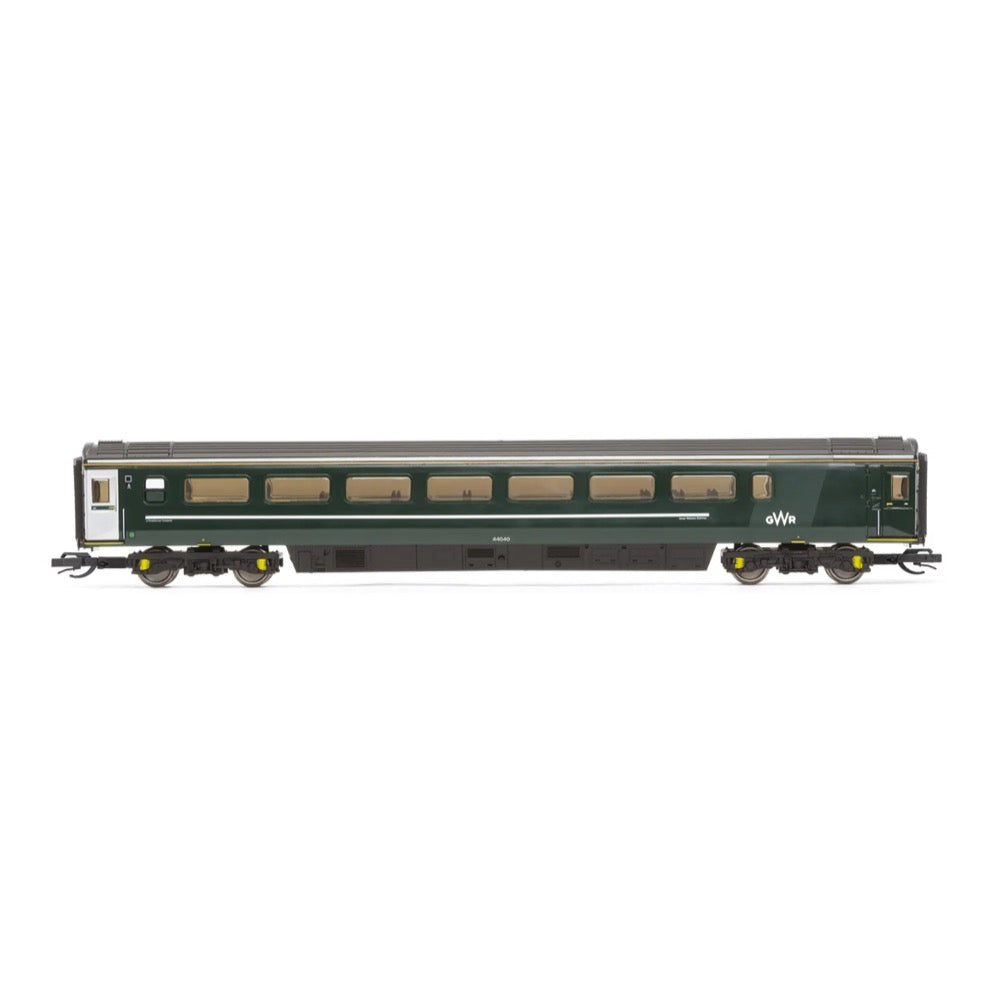
Hornby TT4041 TT GWR Mk3 Trailer Guard Standard 44040
27.00
$
<p>In-order to allow running at 125 mph on Britain's Victorian era railways, new rolling stock was needed by British Railways. Significant improvements over the Mk2 included new secondary air suspension between the bogies and the coach body as well as aerodynamic skirting on the underframe.</p><p>Mk3 coaches are 75ft (23m) long, enabling far greater capacity than older coaches. Mk3 coaches also incorporate disk brakes and wheel slip protection enabling faster deceleration. The first Mk3 coaches to be delivered were used as part of the HST prototype along with the two Class 41 diesel power cars in 1972. Mk3 coaches entered service in 1975 along with the Class 43 forming the iconic InterCity 125 trainset. After the HST Mk3 coach variant was introduced, further Mk3 coaches were introduced to the West Coast Mainline for use as part of locomotive hauled trains. Whilst Mk3 stock is standard for HST units, the standard locomotive hauled stock is Mk3a. Mk3a stock differs from Mk3 stock due to the inclusion of buffers as well as a different electrical system that uses motor generator units in each coach to power air conditioning and other ancillaries Mk3a stock was built until 1984, before 3B stock with improved seating and lighting was built from 1985 to 1988.</p><p>Some 40 years after introduction the Mark 3 coaches and Class 43 units are still in service. One of the most prominent users of the train is the GWR, with their Class 255 Castle sets made up of two 43 units and four coaches. These units were refurbished between 2018 and 2020 to make 12 trains, with the first being introduced in March 2019.</p><h3>Specifications</h3><ul>
<li>Item Length - Without Packaging (cm): 19</li>
<li>Item Height - Without Packaging (cm): 2.2</li>
<li>Item Width - Without Packaging (cm): 2</li>
<li>Item Weight - Without Packaging: 0.05</li>
<li>Item Scale: 1:120 Scale</li>
<li>Finish: Painted</li>
<li>Colour: Green</li>
<li>Gauge: TT</li>
<li>Operator: GWR</li>
<li>Designer: BR</li>
<li>Livery: GWR Green</li>
<li>Minimum Curve (mm): Radius 1</li>
<li>Number of Parts: 1</li>
</ul>
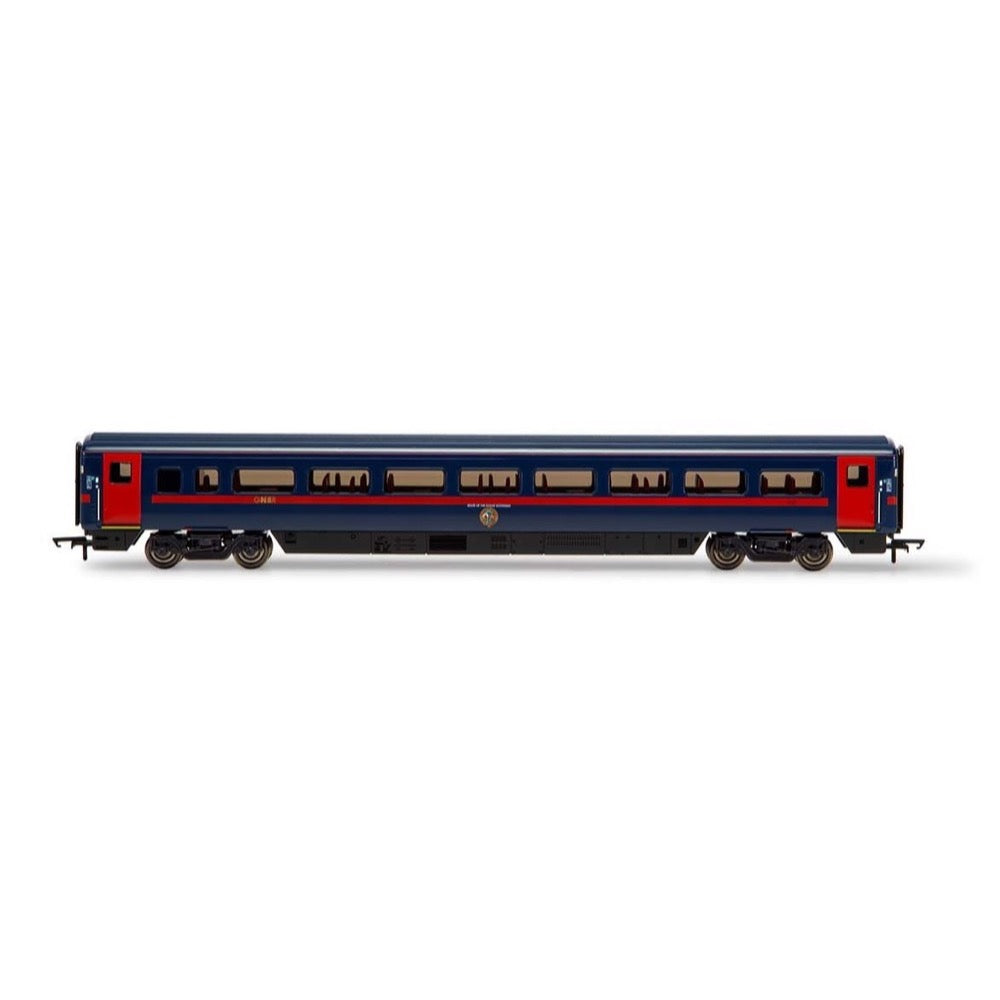
Hornby R40166A OO GNER Mk4 Standard Coach C
40.00
$
<p>Built at Metro-Cammell's Washwood Heath factory, 314 Mk4 coaches were produced between 1989 and 1992. They were built specifically for use on the newly electrified East Coast Main Line, along with hopes that a second order for the West Coast Main Line would be placed at a later date, although this second order never transpired. Mk4 coaches featured many improvements over the Mk3s such as push-button operated plug-type doors, fully sealed gangways and a designed top speed of 140mph. Much of the Mk4 design was based upon the Advanced Passenger Train. In particular, Mk4 coaches feature sides profiled to allow a tilt of up to 6° with newly fitted tilting bogies.</p>
<p>Mk4s entered service in 1989 and helped drive a significant increase in passenger traffic. With privatisation in 1996, all Mk4 coaches were sold to Evershot Rail Group who have since leased them out to the holder of the InterCity East Coast Franchise. The franchise was initially awarded to Great North Eastern Railway (GNER) and has since been operated by National Express East Coast, East Coast, Virgin Trains East Coast and London North Eastern Railway (LNER) owned by the Department for Transport.</p>
<p>Between October 2003 and November 2005 Bombardier Transportation, under contract from GNER, commenced refurbishment of the Mk4 stock, fitting new seating arrangements and introduced onboard Wi-Fi, a first for British rail services. This refurbishment programme was called 'Project Mallard' named after the Mallard steam locomotive, built in the 1930s by the London & North Eastern Railway and holder of the world speed record for steam locomotives.</p>
<p>Although Mk4 coaches have spent most of their lives on the ECML, there are plans to cascade them down to other lines due to the introduction of the Class 800 and Class 801 IEPs.</p>
<h3>Specification</h3>
<ul>
<li>Item Length - Without Packaging (cm): 33</li>
<li>Item Height - Without Packaging (cm): 5</li>
<li>Item Width - Without Packaging (cm): 3.5</li>
<li>Item Weight - Without Packaging: 0.2</li>
<li>Item Scale: 1:76 Scale 00 Gauge</li>
<li>Finish: Painted</li>
<li>License: No</li>
<li>Colour: Blue</li>
<li>Gauge: OO</li>
<li>Operator: GNER</li>
<li>Designer: Met Cam</li>
<li>Livery: GNER</li>
<li>Minimum Curve (mm): Radius 2</li>
<li>Number of Parts: 1</li>
</ul>
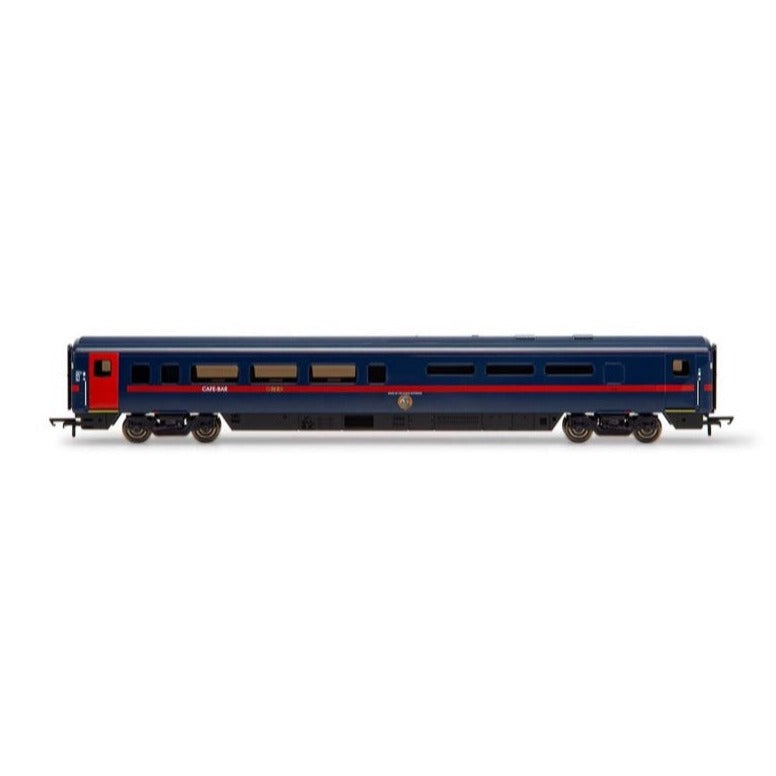
Hornby R40146 OO GNER Mk4 Standard/Kitchen Coach H
40.00
$
<p>Built at Metro-Cammell's Washwood Heath factory, 314 Mk4 coaches were produced between 1989 and 1992. They were built specifically for use on the newly electrified East Coast Main Line, along with hopes that a second order for the West Coast Main Line would be placed at a later date, although this second order never transpired. Mk4 coaches featured many improvements over the Mk3s such as push-button operated plug-type doors, fully sealed gangways and a designed top speed of 140mph. Much of the Mk4 design was based upon the Advanced Passenger Train. In particular, Mk4 coaches feature sides profiled to allow a tilt of up to 6° with newly fitted tilting bogies.</p>
<p>Mk4s entered service in 1989 and helped drive a significant increase in passenger traffic. With privatisation in 1996, all Mk4 coaches were sold to Evershot Rail Group who have since leased them out to the holder of the InterCity East Coast Franchise. The franchise was initially awarded to Great North Eastern Railway (GNER) and has since been operated by National Express East Coast, East Coast, Virgin Trains East Coast and London North Eastern Railway (LNER) owned by the Department for Transport.</p>
<p>Between October 2003 and November 2005 Bombardier Transportation, under contract from GNER, commenced refurbishment of the Mk4 stock, fitting new seating arrangements and introduced onboard Wi-Fi, a first for British rail services. This refurbishment programme was called 'Project Mallard' named after the Mallard steam locomotive, built in the 1930s by the London & North Eastern Railway and holder of the world speed record for steam locomotives.</p>
<p>Although Mk4 coaches have spent most of their lives on the ECML, there are plans to cascade them down to other lines due to the introduction of the Class 800 and Class 801 IEPs.</p>
<h3>Specifications</h3>
<ul>
<li>Item Length - Without Packaging (cm): 33</li>
<li>Item Height - Without Packaging (cm): 5</li>
<li>Item Width - Without Packaging (cm): 3.5</li>
<li>Item Weight - Without Packaging: 0.2</li>
<li>Item Scale: 1:76 Scale 00 Gauge</li>
<li>License: No</li>
<li>Finish: Painted</li>
<li>Colour: Blue</li>
<li>Gauge: OO</li>
<li>Operator: GNER</li>
<li>Designer: Met Cam</li>
<li>Livery: GNER</li>
<li>Minimum Curve (mm): Radius 2</li>
<li>Number of Parts: 1</li>
</ul>
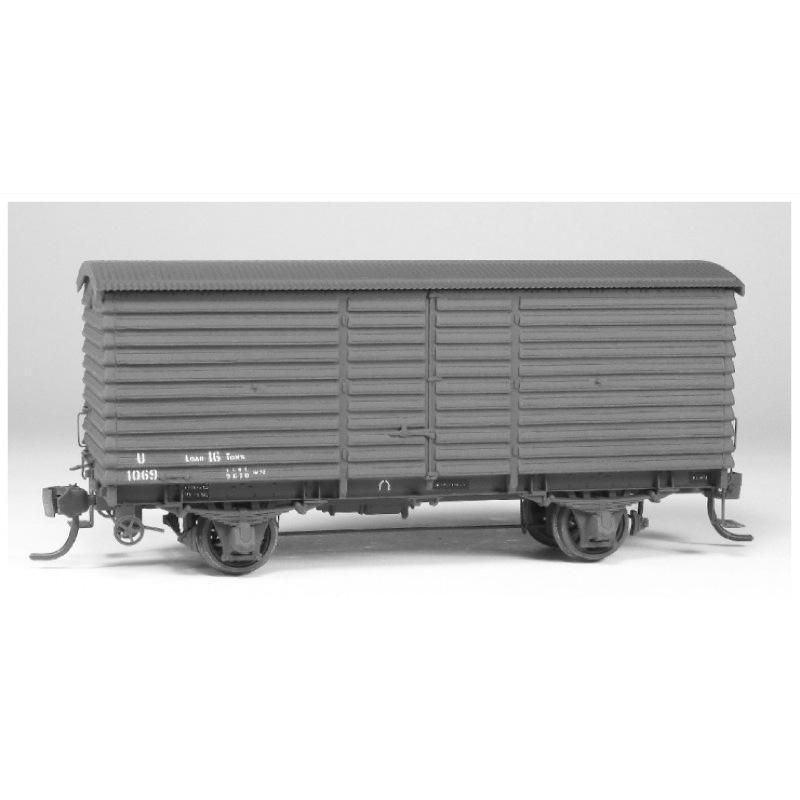
Steam Era Models R4W HO U Lourve Van Wheel Handbrake Kit
10.00
$
<h3>U Louvre Van, 16 ton, Wheel Handbrake kit</h3>
<p>The U van was designed for the carriage of perishable goods, although other classes of goods could be carried under certain conditions. Seventy five vans numbered from 992 to 1066 were built with six wheeled underframes at Newport Workshops during 1925. These vans also featured a 7'0" wide doorway each side and a corrugated iron double roof. During 1934-35 forty four vans from this series were rebuilt with auto' coupled bogie underframes and recoded UB, whilst the remaining thirty one vans were rebuilt with four wheeled underframes and also fitted with auto' couplers. A further two hundred vans were built new with four wheeled, auto' coupled underframes at Newport and Bendigo Nth Workshops between 1934 and 1939, being numbered 1067 to 1266.</p>
<p>This kit can be assembled to represent a van from the series 992 to 1216, which features a wheel type handbrake, wide doors and a corrugated iron double roof. The final fifty vans built at Bendigo Nth during 1939, as well as two hundred four wheeled vans with a similar style body constructed at Newport Workshops in 1946/47 and 1951/52, featured a lever style handbrake.</p>
<p><em>Model illustrated has been fitted with couplers (not included).</em></p>
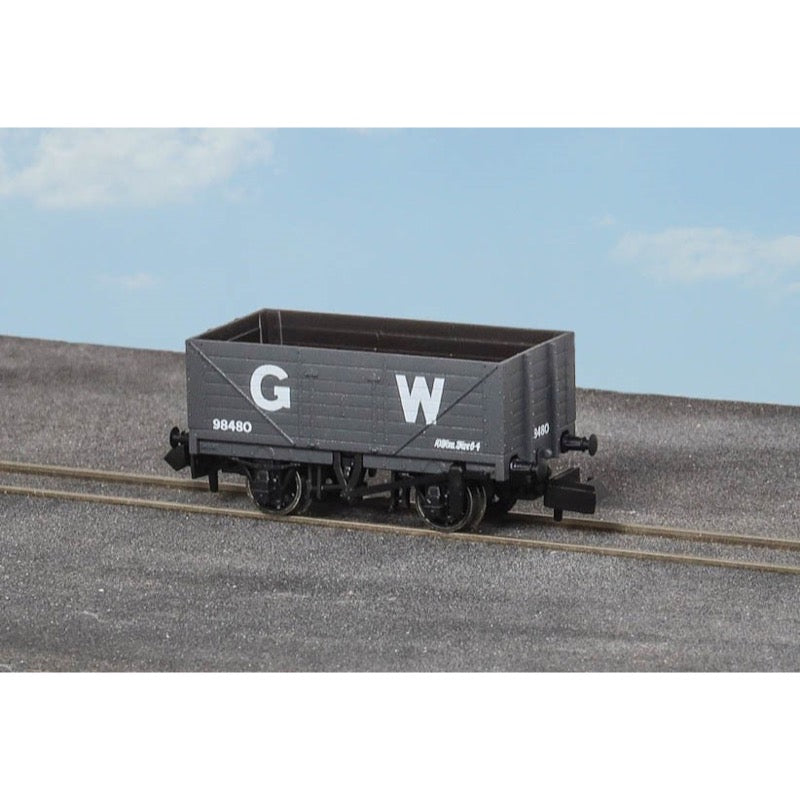
PECO NR7000W N RTR 9ft 7 Plank Open Wagon GWR Grey
21.00
$
<h3>Features</h3>
<ul>
<li>Scale 9 foot wheelbase</li>
<li>Brand new, finely-detailed moulding</li>
<li>Finely printed text and art work, including on the wagons ends as appropriate</li>
<li>Interior details</li>
<li>Metal-tyred disc or spoked wheels</li>
<li>NEM355 coupling pocket</li>
<li>Finely-detailed brake rigging with shoes in-line with the wheels</li>
<li>Body-coloured sole bars where appropriate</li>
</ul>


